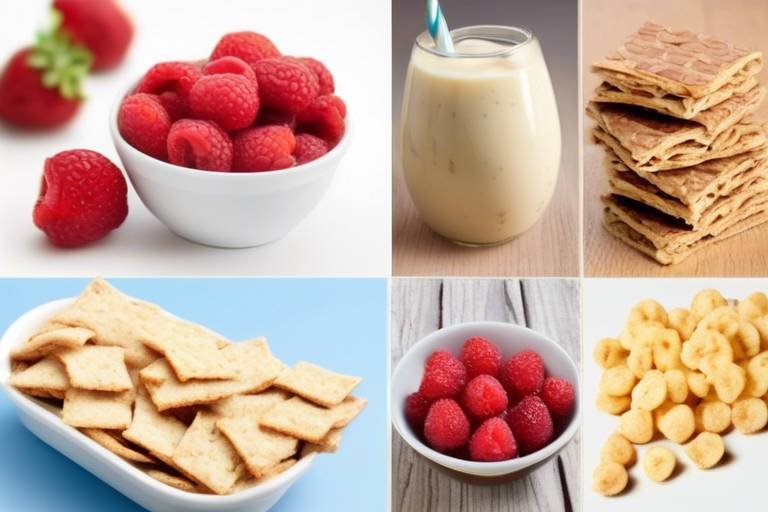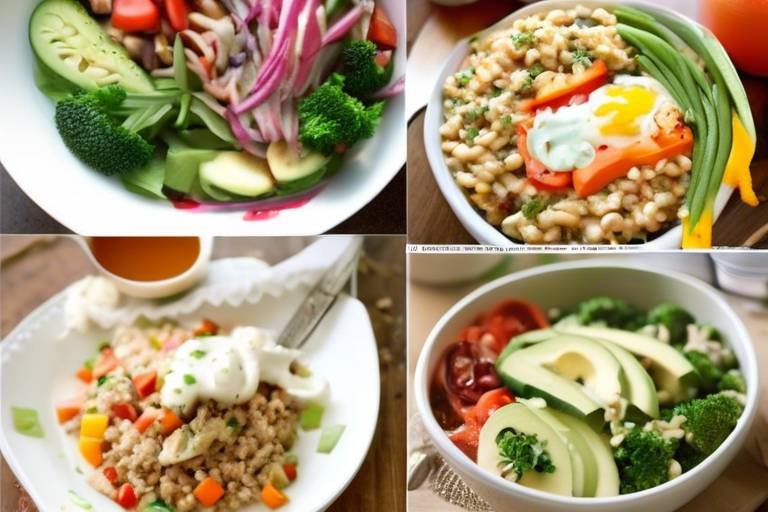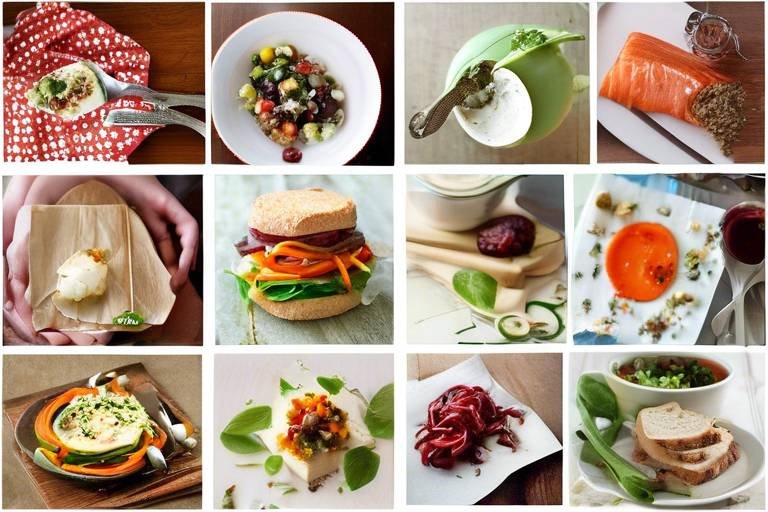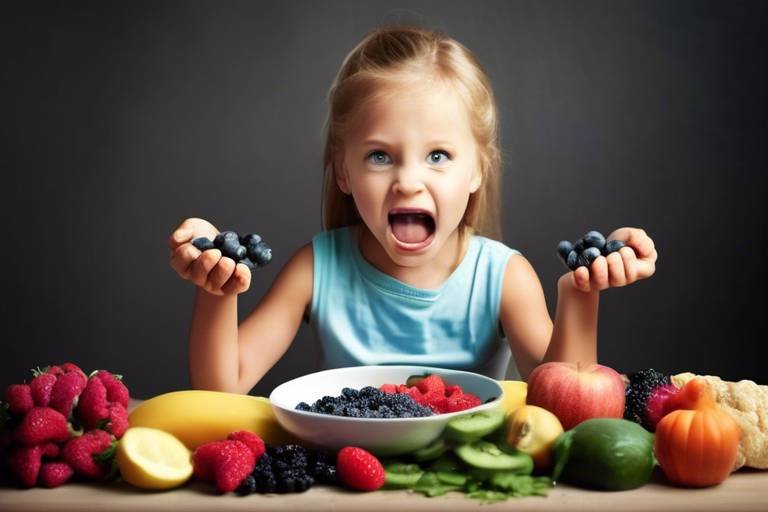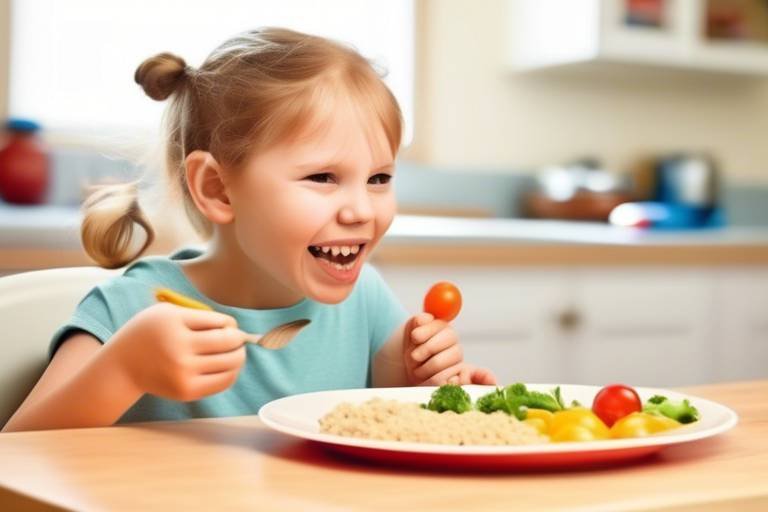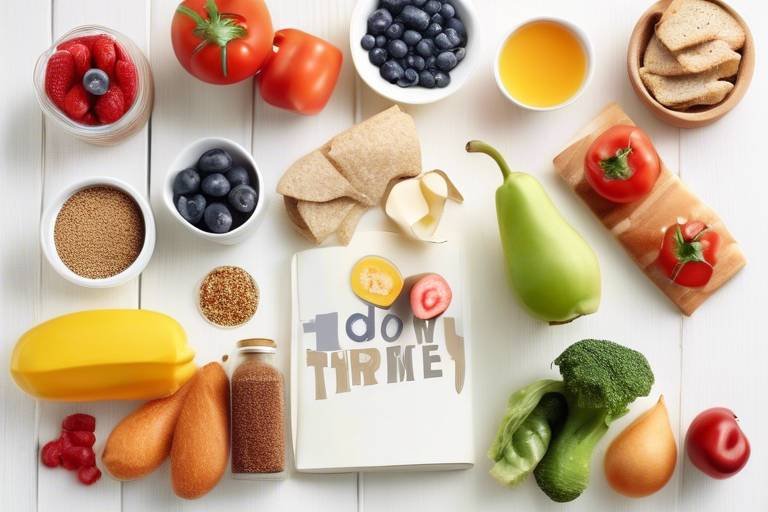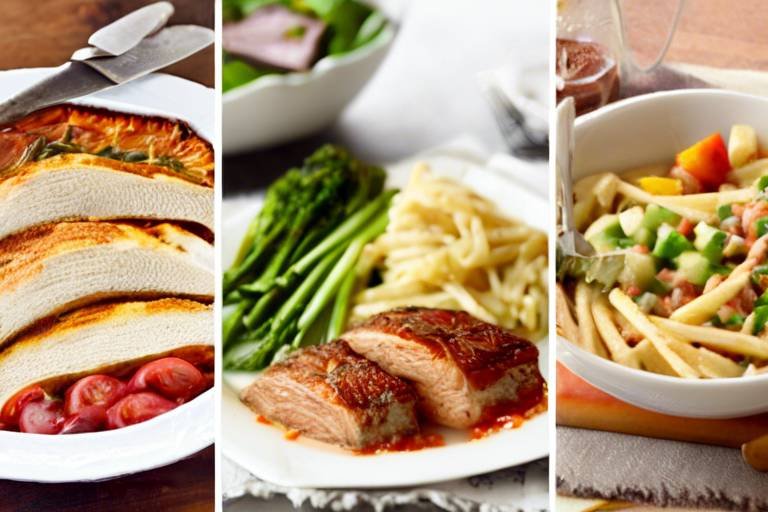Teaching Kids the Importance of Balanced Eating
In today's fast-paced world, where junk food often seems more accessible than healthy options, teaching kids the importance of balanced eating has become a crucial task for parents and educators alike. It's not just about telling them what to eat; it's about instilling a sense of responsibility towards their own nutrition and health. When children understand the value of a nutritious diet, they are more likely to make informed choices that will benefit them for a lifetime. But how do we go about this? How do we transform the daunting concept of balanced eating into something that feels fun and engaging for kids?
One effective strategy is to create a positive atmosphere around food. Instead of viewing healthy eating as a chore, we can frame it as an exciting adventure. Imagine exploring a colorful world of fruits and vegetables, where each color represents a different nutrient that helps our bodies grow strong and healthy! By making eating an exploratory journey, we can spark curiosity in children, encouraging them to try new foods and flavors.
Additionally, involving children in the process of meal planning and preparation can enhance their understanding of balanced eating. When kids participate in choosing recipes, shopping for ingredients, and even cooking, they develop a connection to their food that goes beyond just consumption. They start to see food as a source of energy and nourishment rather than just something to fill their bellies. This hands-on approach not only educates them about nutrition but also fosters a sense of accomplishment and pride in their meals.
As we embark on this journey of teaching kids about balanced eating, it's essential to remember that patience and consistency are key. Children may not embrace healthy habits overnight, but with ongoing support and encouragement, they can learn to make better food choices. So, let's dive deeper into the foundational elements of balanced eating, exploring the nutritional basics, creating balanced plates, and discovering fun ways to get kids involved in their food journey!
A foundational knowledge of nutrition helps children make informed food choices. This section will cover macronutrients, micronutrients, and the role they play in a balanced diet.
Teaching kids how to create a balanced plate is essential. This section will outline portion sizes and the food groups necessary for a nutritious meal, making it easy for children to visualize.
Understanding the different food groups—fruits, vegetables, grains, proteins, and dairy—enables children to appreciate variety in their diet. This section provides an overview of each group and its benefits.
Fruits and vegetables are vital for health. This subsection discusses the importance of colorful choices and how to incorporate them into meals and snacks for children.
This section explains the differences between whole and refined grains, highlighting the benefits of whole grains for children's energy levels and overall health.
Snacking can be part of a balanced diet. Here, we will explore nutritious snack ideas that are appealing to kids, ensuring they maintain energy levels throughout the day.
Engaging children in meal preparation fosters a connection to food. This section discusses fun, interactive ways to involve kids in cooking, enhancing their understanding of balanced eating.
Incorporating fun cooking activities can make learning about balanced eating enjoyable. This subsection shares creative ideas for cooking together, encouraging kids to experiment with healthy ingredients.
Taking kids grocery shopping can teach them about selecting healthy foods. This section provides tips on how to make shopping trips educational and enjoyable for children.
Children learn from their parents' habits. This section emphasizes the importance of modeling balanced eating behaviors to encourage kids to adopt healthy eating patterns.
Sharing meals as a family can strengthen bonds and promote healthy eating. This subsection discusses the benefits of regular family meals and how they can improve children's dietary choices.
Open discussions about food choices can empower children to make healthier decisions. This section explores strategies for having constructive conversations about nutrition and balanced eating with kids.
- Why is it important for kids to learn about balanced eating? Teaching kids about balanced eating helps them make healthier choices, leading to better health outcomes in the long run.
- How can I make healthy eating fun for my kids? Involve them in meal planning and preparation, and use creative presentations to make healthy foods more appealing.
- What are some healthy snacks for kids? Options include fruits, yogurt, nuts, and whole-grain crackers, which are both nutritious and tasty.

Understanding Nutritional Basics
Understanding the fundamentals of nutrition is like having a treasure map to a healthier life. It’s essential for children to grasp the basics, as this knowledge empowers them to make informed food choices. At its core, nutrition can be broken down into two main categories: macronutrients and micronutrients. Each plays a vital role in our bodies, and knowing how they work can help kids appreciate the food they eat.
Macronutrients are the nutrients that provide us with energy. They include carbohydrates, proteins, and fats. Think of them as the building blocks of our diet:
- Carbohydrates: Often referred to as the body's main fuel source, these are found in foods like bread, pasta, fruits, and vegetables.
- Proteins: These are crucial for growth and repair. Foods like meat, beans, and nuts are great sources.
- Fats: While often misunderstood, fats are necessary for energy and supporting cell growth. Healthy fats can be found in avocados, olive oil, and fish.
On the other hand, micronutrients are vitamins and minerals that, although needed in smaller amounts, are equally important for overall health. They help in processes like immune function, bone health, and energy production. Common micronutrients include:
- Vitamin C: Found in citrus fruits, it’s essential for a healthy immune system.
- Calcium: Important for strong bones, found in dairy products and leafy greens.
- Iron: Crucial for transporting oxygen in the blood, found in meats and beans.
By understanding these nutritional basics, children can learn to appreciate the importance of a balanced diet. It’s not just about eating; it’s about fueling their bodies for play, learning, and growth. Parents can help by discussing the benefits of each food group and encouraging kids to try a variety of foods.
To illustrate the importance of these nutrients, consider this simple table that summarizes the key roles of macronutrients and micronutrients:
| Nutrient Type | Examples | Key Functions |
|---|---|---|
| Macronutrients | Carbohydrates, Proteins, Fats | Energy, Growth, Repair |
| Micronutrients | Vitamins, Minerals | Immune Function, Bone Health, Energy Production |
In conclusion, teaching kids about nutritional basics sets the stage for a lifetime of healthy eating habits. When children understand what they are putting into their bodies and why it matters, they are more likely to make choices that support their health and well-being. It’s like giving them a toolkit for life—one that can help them build a strong foundation for their future.

Creating a Balanced Plate
When it comes to teaching children about healthy eating, one of the most effective strategies is to help them understand how to create a balanced plate. This concept is not just a guideline; it's a visual tool that simplifies the process of meal planning and encourages children to make nutritious choices. Imagine your plate as a colorful palette, where each food group adds a unique hue to the masterpiece of your meal. By focusing on portion sizes and the essential food groups, children can easily visualize what a nutritious meal looks like.
To create a balanced plate, it's important to incorporate a variety of food groups. A good rule of thumb is to divide the plate into sections that represent different food categories. Here’s a simple breakdown:
| Food Group | Recommended Portion | Examples |
|---|---|---|
| Fruits | 1/4 of the plate | Apples, bananas, berries |
| Vegetables | 1/2 of the plate | Carrots, broccoli, spinach |
| Grains | 1/4 of the plate | Brown rice, whole wheat pasta, quinoa |
| Protein | 1/4 of the plate | Chicken, beans, tofu |
| Dairy | Side serving | Milk, yogurt, cheese |
By using this visual representation, children can easily grasp the idea of a balanced meal. For instance, when they sit down to eat, they should aim to fill half their plate with a rainbow of fruits and vegetables. This not only ensures they get a wide range of vitamins and minerals but also makes their meals visually appealing. Encourage them to try different colors and textures, as each one offers unique health benefits. Just like an artist chooses different colors to create depth in a painting, children can learn to appreciate the variety in their meals.
Additionally, it’s crucial to explain the importance of portion sizes. Children often have a hard time understanding how much food they actually need. By teaching them to listen to their bodies and recognize when they are full, you can help them develop a healthy relationship with food. Use analogies, like comparing their stomach to a balloon that expands and contracts, to make this concept relatable. This way, they can learn to enjoy their meals without overeating.
Finally, don’t forget to emphasize the role of healthy fats in their diet. While fats often get a bad rap, they are essential for growth and brain development. Encourage kids to include sources of healthy fats, such as avocados, nuts, and olive oil, in their meals. This can be as simple as adding slices of avocado to their sandwiches or mixing nuts into their yogurt. By integrating these healthy options into their balanced plate, children will not only enjoy their food more but also benefit from the essential nutrients these fats provide.
In summary, teaching kids how to create a balanced plate is a vital step in promoting lifelong healthy eating habits. By using visual aids, discussing portion sizes, and encouraging variety, children can learn to make informed food choices that will serve them well throughout their lives. Remember, the goal is to make healthy eating an enjoyable and engaging experience, so they grow up with a positive attitude towards food.

Food Groups Explained
Understanding the different food groups is crucial for children to appreciate the variety in their diet. Each food group plays a unique role in providing essential nutrients that support growth, development, and overall health. When kids learn about these groups, they become more empowered to make healthy choices. Let's break down the main food groups and their benefits:
1. Fruits: Fruits are nature's candy, packed with vitamins, minerals, and fiber. They come in various colors, shapes, and flavors, making them appealing to kids. Eating a rainbow of fruits not only helps children get essential nutrients but also encourages them to explore different tastes. For instance, berries are rich in antioxidants, while bananas provide a quick energy boost due to their carbohydrate content.
2. Vegetables: Just like fruits, vegetables are vital for a balanced diet. They are low in calories but high in essential nutrients. Teaching kids to enjoy a variety of vegetables, especially colorful ones like carrots, spinach, and bell peppers, can help them develop a taste for healthy foods. Incorporating veggies into meals can be as simple as adding them to stir-fries, salads, or even smoothies!
3. Grains: Grains are a significant source of energy for children. However, not all grains are created equal. Whole grains, such as brown rice, quinoa, and whole wheat bread, retain their bran and germ, making them higher in fiber and nutrients compared to refined grains like white bread and pasta. Teaching kids to choose whole grains over refined options can help maintain their energy levels and support digestive health.
4. Proteins: Proteins are essential for growth and repair. They help build muscles and are crucial for developing strong bodies. Kids can get protein from various sources, including meat, fish, eggs, beans, and nuts. Introducing a variety of protein sources can make meals more exciting and nutritious. For example, a fun taco night can include ground turkey, black beans, and plenty of toppings!
5. Dairy: Dairy products are vital for bone health, providing calcium and vitamin D necessary for growing children. Options like milk, yogurt, and cheese can be delicious and nutritious. However, for those who are lactose intolerant or prefer non-dairy options, alternatives like almond milk and coconut yogurt can also provide essential nutrients.
To visualize how these food groups come together, consider the following table that summarizes the key benefits of each group:
| Food Group | Key Nutrients | Benefits |
|---|---|---|
| Fruits | Vitamins, Fiber | Boosts immunity, aids digestion |
| Vegetables | Vitamins, Minerals | Supports overall health, low in calories |
| Grains | Carbohydrates, Fiber | Provides energy, supports digestion |
| Proteins | Amino Acids | Builds muscles, repairs tissues |
| Dairy | Calcium, Vitamin D | Strengthens bones, supports growth |
By understanding these food groups and their benefits, children can learn to appreciate the diversity of food available to them. This knowledge not only empowers them to make healthier choices but also fosters a positive relationship with food that can last a lifetime. So, the next time your child reaches for a snack, remind them of the colorful, nutritious options available to them!

Fruits and Vegetables
are not just colorful additions to our plates; they are essential building blocks of a healthy diet, especially for growing children. These food groups are packed with vitamins, minerals, and fiber, which are crucial for maintaining energy levels, supporting growth, and preventing illnesses. Imagine your body as a car; just like a vehicle needs high-quality fuel to run smoothly, your body requires the right nutrients to function optimally. By incorporating a variety of fruits and vegetables into daily meals, kids can enjoy a rainbow of flavors and textures while reaping numerous health benefits.
One of the most exciting aspects of fruits and vegetables is their vibrant colors, which often indicate different nutrients. For instance, orange and yellow fruits like oranges and mangoes are rich in vitamin C, while green vegetables such as spinach and broccoli are packed with iron and calcium. By encouraging children to choose a variety of colors, we can help them understand the importance of diversity in their diet. Have you ever heard the saying, "Eat the rainbow"? This simple phrase can serve as a fun reminder for kids to include a wide range of produce in their meals.
Incorporating fruits and vegetables into snacks can also be a delightful experience. For example, consider making a fruit salad together or creating colorful vegetable sticks with hummus for dipping. These activities not only make eating healthy fun but also foster a sense of ownership over their food choices. When children actively participate in selecting and preparing their snacks, they are more likely to appreciate and enjoy the flavors and benefits of fruits and vegetables.
Another great way to encourage kids to eat more fruits and vegetables is through creative presentations. Transforming a simple apple into a funny face with peanut butter and raisins can spark excitement and curiosity. Likewise, arranging veggies in the shape of a rainbow on a platter can make healthy eating feel like an adventure. It's all about making these nutritious foods appealing and engaging!
In addition to their nutritional benefits, fruits and vegetables can also be a source of fun and learning opportunities. For instance, you might want to explore local farmers' markets together, where children can learn about seasonal produce and even meet the farmers who grow their food. This experience can deepen their connection to what they eat and inspire them to try new fruits and vegetables. Remember, the goal is to create a positive association with these healthy foods, so keep the atmosphere light and enjoyable!
In conclusion, instilling a love for fruits and vegetables in children is a vital step toward fostering lifelong healthy eating habits. By making these foods accessible, fun, and engaging, we can help our kids develop a strong appreciation for nutrition that lasts a lifetime. After all, when children understand the importance of what they eat, they are more likely to make informed choices that benefit their health.
- How can I encourage my child to eat more fruits and vegetables?
Try involving them in meal prep, presenting foods creatively, and setting a positive example by eating these foods yourself.
- What are some easy ways to incorporate more fruits and vegetables into meals?
Add them to smoothies, include them in sauces, or serve them as snacks with dips like yogurt or hummus.
- Are frozen fruits and vegetables as nutritious as fresh ones?
Yes! Frozen options can be just as nutritious and are often picked at peak ripeness, making them a convenient choice.

Whole Grains vs. Refined Grains
When it comes to understanding the difference between whole grains and refined grains, it’s essential to grasp why whole grains are often celebrated as the healthier choice. Whole grains include the entire grain kernel—meaning they contain the bran, germ, and endosperm. This means they're packed with fiber, vitamins, and minerals, making them a powerhouse for your child's diet. On the other hand, refined grains have been milled to remove the bran and germ, resulting in a finer texture but stripping away valuable nutrients. Think of whole grains as a complete meal, while refined grains are like a meal missing its key ingredients.
To illustrate the differences more clearly, let’s look at some common examples:
| Whole Grains | Refined Grains |
|---|---|
| Brown rice | White rice |
| Whole wheat bread | White bread |
| Oats | Instant oatmeal |
| Quinoa | Regular pasta |
One of the most significant benefits of whole grains is their ability to keep your child feeling full longer. The fiber found in whole grains aids digestion and helps regulate blood sugar levels, which can prevent those pesky energy crashes that often come from consuming refined grains. Imagine your child as a car; whole grains are like high-quality fuel that keeps the engine running smoothly, while refined grains are akin to low-grade fuel that doesn’t provide the same power or efficiency.
Moreover, incorporating whole grains into your child's diet can be a fun adventure! You can explore various whole grain options together, such as adding whole grain pasta to their favorite dishes or trying out different types of bread. By doing this, you’re not just enhancing their meals; you’re also introducing them to a world of flavors and textures that can make balanced eating exciting. So, next time you’re at the grocery store, why not challenge them to find a new whole grain product to try?
In summary, choosing whole grains over refined grains is a simple yet impactful decision that can significantly benefit your child’s health. By understanding the differences and incorporating whole grains into their meals, you’re setting them up for a lifetime of healthy eating habits. Remember, every small change counts when it comes to nutrition!
- What are some examples of whole grains? Whole grains include brown rice, quinoa, whole wheat bread, and oats.
- Why are whole grains better than refined grains? Whole grains contain more nutrients and fiber, which help with digestion and keep you feeling full longer.
- How can I incorporate more whole grains into my child's diet? Try swapping out white bread for whole grain bread, using brown rice instead of white rice, or adding whole grain pasta to their favorite meals.

Healthy Snacking Options
Snacking is often seen as the enemy when it comes to maintaining a balanced diet, but it doesn't have to be! In fact, healthy snacking can play a crucial role in keeping kids energized and satisfied throughout the day. Imagine your child as a little engine; they need the right fuel to keep chugging along! By introducing them to nutritious snacks, you can ensure that their "engine" runs smoothly without any hiccups.
So, what are some that kids will actually enjoy? The key is to combine taste with nutrition, making snacks not only good for them but also fun to eat. Think of snacks as mini-meals that can bridge the gap between larger meals, helping to maintain energy levels and stave off hunger. Here are some ideas to consider:
- Fruit Kabobs: Kids love food on a stick! Thread pieces of colorful fruits like strawberries, grapes, and melon onto skewers for a fun and visually appealing snack.
- Veggie Dips: Pair crunchy veggies such as carrots, cucumbers, and bell peppers with a tasty dip like hummus or yogurt-based dressing. This not only adds flavor but also encourages kids to munch on their greens.
- Nut Butter and Apples: Spread a thin layer of almond or peanut butter on apple slices for a sweet and satisfying treat that packs a protein punch.
It's important to remember that healthy snacks should be simple to prepare and easy to grab on the go. Think of them as little pockets of nutrition that can be enjoyed anytime. You might even consider creating a "snack station" at home, where kids can choose from a variety of pre-portioned healthy snacks. This not only gives them the freedom to make their own choices but also teaches them about moderation and portion control.
Incorporating whole grains into snacks is another fantastic way to boost their nutritional value. Whole grain crackers or rice cakes topped with cheese or avocado can be a hit. And don’t forget about the power of yogurt! A small cup of plain or Greek yogurt can be a deliciously creamy base for adding fruits or a sprinkle of granola, making it a delightful treat.
Lastly, consider involving your kids in the snacking process. Have them help you prepare these snacks, allowing them to take ownership of their choices. This not only makes them more likely to eat what they’ve helped create but also reinforces the idea of balanced eating. By making healthy snacks a fun and interactive part of their day, you're setting them up for a lifetime of healthy habits.
Q: How can I encourage my kids to choose healthy snacks?
A: Lead by example! Make healthy snacks available and involve them in the preparation process. The more they engage with food, the more likely they are to make healthier choices.
Q: What are some quick healthy snacks for busy days?
A: Some quick options include yogurt cups, pre-cut fruits and veggies, whole grain granola bars, or even a handful of nuts. These can be prepared in advance for easy access.
Q: Are store-bought snacks ever healthy?
A: Yes, many store-bought snacks can be healthy! Look for options that are low in added sugars and high in whole ingredients. Always check the nutrition label to make informed choices.

Involving Kids in Meal Preparation
Engaging children in meal preparation is a fantastic way to foster a connection to food while teaching them about the importance of balanced eating. When kids participate in cooking, they not only learn valuable skills but also develop a sense of ownership over their food choices. Imagine the joy on their faces when they see a meal they helped create! It's like turning them into little chefs, excited to explore the culinary world. So, how can we make this experience both educational and fun?
First, start with simple recipes that allow kids to contribute meaningfully without feeling overwhelmed. For instance, let them wash vegetables, mix ingredients, or even choose toppings for a homemade pizza. These small tasks can significantly boost their confidence and make them feel like they’re part of the process. You might even consider creating a family recipe book where they can write down their favorite meals, adding a personal touch to your culinary adventures.
Another great idea is to introduce themed cooking nights. For example, you could have a “Taco Tuesday” where everyone can customize their own tacos with a variety of healthy ingredients. This not only makes dinner exciting but also encourages kids to try new foods. They might discover they love avocados or black beans when they get to choose! Plus, it’s a wonderful opportunity to discuss the nutritional value of each ingredient as you prepare the meal together.
Involving kids in meal prep goes beyond just cooking; it can also include planning meals. Sit down together and brainstorm healthy meals for the week. This not only teaches them about balanced eating but also helps them understand the importance of meal planning. You can create a simple
| Day | Meal | Involvement |
|---|---|---|
| Monday | Vegetable Stir-Fry | Chopping veggies |
| Tuesday | Taco Night | Choosing toppings |
| Wednesday | Homemade Pizza | Spreading sauce |
By making meal planning a family affair, you’re teaching kids to think critically about what they eat and why it matters. They’ll learn to appreciate a variety of foods, understand portion sizes, and develop a sense of what constitutes a balanced meal.
Lastly, don’t forget the importance of having fun in the kitchen! Turn up the music and dance while you cook, or have a little competition to see who can create the most colorful plate. These moments create lasting memories and establish a positive relationship with food that can last a lifetime. So, roll up those sleeves and get cooking together – it’s a delicious way to bond and learn!
Q: How can I encourage my child to try new foods while cooking?
A: Involve them in the cooking process by allowing them to choose one new ingredient each week. Encourage them to help prepare it and discuss its taste and texture.
Q: What are some easy recipes to start with?
A: Begin with simple recipes like smoothies, sandwiches, or homemade pizzas where kids can easily participate in assembling and customizing their meals.
Q: How can I make grocery shopping educational for my kids?
A: Create a shopping list together and let them find items in the store. Discuss healthy options and why they are important for a balanced diet.

Fun Cooking Activities
Cooking with kids is not just about preparing meals; it’s a delightful journey that can ignite their passion for healthy eating. Imagine the joy on their faces as they mix, stir, and create something delicious! Engaging children in the kitchen can transform a mundane task into a fun and educational experience. Here are some creative activities that can make cooking a blast for the whole family:
One fantastic way to get kids involved is by organizing a theme night. For instance, you might have a taco night where everyone can customize their own tacos. Provide a variety of colorful toppings like diced tomatoes, shredded lettuce, and guacamole. This not only allows children to express their creativity but also encourages them to try new ingredients. Plus, who doesn’t love tacos?
Another exciting activity is to turn cooking into a science experiment. Kids can learn about measurements and chemical reactions by baking. For example, when making cookies, you can explain how baking soda reacts with acid to create carbon dioxide, which makes the cookies rise. This hands-on experience not only teaches them about ingredients but also the science behind cooking!
Don’t forget about the power of color! Challenge your children to create a dish that includes every color of the rainbow. This can be a fun way to introduce them to different fruits and vegetables. As they chop, mix, and present their colorful creations, you can talk about the nutritional benefits of each color. For example, orange foods like carrots are great for eyesight, while green foods like spinach are packed with iron.
Additionally, consider hosting a mini cooking competition. Set a timer and have your kids prepare a dish using a few specific ingredients. This not only sparks their creativity but also teaches them to think on their feet. You can even invite family members to be the judges, making it a fun family event that everyone looks forward to!
Lastly, make sure to include clean-up time as part of the cooking activity. Teach your children the importance of tidying up after cooking. You can turn this into a game by timing how quickly they can clean up, making it a fun challenge rather than a chore. This not only instills good habits but also reinforces teamwork as everyone pitches in to help.
By incorporating these fun cooking activities, you’ll not only enhance your child’s understanding of balanced eating but also create lasting memories in the kitchen. The key is to keep the atmosphere light and enjoyable, allowing your kids to explore their culinary skills while learning about nutrition in an engaging way.
Q: What age should I start involving my kids in cooking?
A: You can start involving kids in cooking as early as 2-3 years old. Simple tasks like washing vegetables or stirring batter are great for toddlers. As they grow older, you can introduce more complex tasks.
Q: How can I make cooking more educational?
A: Incorporate lessons about nutrition, measurements, and even cultural history behind certain dishes. Use cooking as an opportunity to teach them about healthy eating habits and the importance of balanced meals.
Q: What if my child is picky about food?
A: Involve them in the cooking process and let them choose ingredients. When they have a hand in making the food, they may be more willing to try new things.
Q: How do I keep cooking safe for kids?
A: Always supervise children closely, especially when using sharp utensils or heat sources. Teach them about kitchen safety and the importance of washing their hands before handling food.

Grocery Shopping Together
Taking your kids grocery shopping can be a delightful adventure! It’s not just about filling up your cart; it’s an *invaluable opportunity* to teach them about nutrition and the importance of making healthy choices. Think of the grocery store as a giant classroom filled with colorful displays and a plethora of food options. When you involve your children in the shopping process, you’re not only making it fun but also instilling lifelong habits that can lead to better health.
Start by discussing the grocery list before you even set foot in the store. Explain to your kids why certain items are on the list and how they contribute to a balanced diet. For instance, you can say, “We’re picking up fruits and vegetables because they help us stay strong and healthy!” This simple conversation can spark their interest in nutrition and make them feel included in the decision-making process.
As you navigate the aisles, encourage your kids to read labels and compare products. This can be a great way to teach them about nutritional values and ingredients. Ask questions like, “Which cereal has more fiber?” or “What do you think is healthier, this snack or that one?” Such questions not only engage their critical thinking skills but also empower them to make informed choices. You might even consider creating a mini-challenge where they find the healthiest option within a certain category. It’s like a scavenger hunt, but for nutrition!
Moreover, discussing seasonal produce can add another layer of learning. For example, you can explain how certain fruits and vegetables are harvested at different times of the year, and why it’s beneficial to eat what’s in season. This can lead to a conversation about sustainability and supporting local farmers, which are important concepts for kids to grasp.
While shopping, don't forget to explore the concept of budgeting. Give them a small amount of money and let them choose how to spend it on healthy snacks. This will teach them about making choices and understanding the value of money, all while reinforcing the idea that healthy eating doesn’t have to break the bank.
Finally, make sure to celebrate the experience! Once you’re back home, you can turn the ingredients into a fun cooking session. This reinforces the connection between shopping and preparing healthy meals, making the whole process feel rewarding. By actively participating in grocery shopping, your kids will develop a deeper appreciation for food and its impact on their health.
- Why is it important to involve kids in grocery shopping? Involving kids in grocery shopping helps them learn about nutrition, budgeting, and making healthy food choices.
- How can I make grocery shopping fun for my kids? Turn it into a game by asking them to find specific items, compare products, or even give them a small budget to spend.
- What should I teach my kids while grocery shopping? Teach them about reading labels, understanding food groups, and the benefits of seasonal produce.

Setting a Positive Example
When it comes to teaching kids about balanced eating, one of the most powerful tools in your arsenal is your own behavior. Children are like little sponges, absorbing everything they see and hear. If they observe their parents or caregivers making healthy food choices, they are more likely to mimic those behaviors. This means that by , you can significantly influence their eating habits and attitudes towards food.
Consider this: if you often indulge in sugary snacks and skip meals, your child may think that’s the norm. On the other hand, if they see you enjoying a colorful salad or a hearty bowl of whole grains, they’ll begin to associate these foods with positivity and health. It’s not just about what’s on the plate, but also about the attitude you bring to the table. Your enthusiasm for trying new foods, cooking together, and discussing the benefits of various ingredients can ignite their curiosity and willingness to explore a balanced diet.
Moreover, the atmosphere during meal times plays a crucial role. Family meals are an excellent opportunity to reinforce healthy eating habits. When you gather around the table, make it a point to share not just food, but also stories and laughter. This creates a positive association with healthy eating, making it more enjoyable for your children. Regular family meals can lead to better dietary choices and improved family bonds.
To further enhance their understanding of balanced eating, engage your children in conversations about food choices. Discuss why certain foods are beneficial and how they affect their bodies. For instance, you might explain how fruits and vegetables provide essential vitamins and minerals that help them grow strong and stay energetic. This kind of dialogue empowers them to make informed decisions about what they eat.
Here are a few ways you can set a positive example:
- Be Mindful of Your Choices: Choose whole foods over processed options whenever possible.
- Involve Kids in Cooking: Let them help with meal prep to foster a connection with healthy ingredients.
- Stay Positive: Approach healthy eating with enthusiasm, sharing your excitement about trying new recipes.
- Encourage Exploration: Introduce a variety of foods and flavors to keep meals interesting.
Remember, consistency is key. If you consistently model healthy eating habits, your children will likely adopt these behaviors over time. It’s all about creating an environment where balanced eating is the norm rather than the exception. In doing so, you’ll not only help them develop a healthy relationship with food but also equip them with the tools they need for a lifetime of wellness.
Q: How can I encourage my child to try new foods?
A: Try involving them in the cooking process, making it a fun activity. Also, offer new foods alongside their favorites to make them more appealing.
Q: What if my child refuses to eat vegetables?
A: Be patient and keep offering them in different forms—raw, cooked, or blended into smoothies. Sometimes, it takes multiple exposures before they accept a new food.
Q: How important are family meals for healthy eating?
A: Family meals are crucial as they provide a platform for discussing food choices and fostering a supportive eating environment. They also strengthen family bonds.

Family Meals
Sharing meals as a family isn't just about the food; it's about building connections, creating memories, and fostering healthy habits that can last a lifetime. Imagine sitting around the dinner table, laughter echoing, stories being shared, and delicious aromas wafting through the air. This is not just a meal; it's an experience that strengthens family bonds while promoting balanced eating. When families come together to eat, it creates a sense of belonging and encourages children to try new foods, ultimately expanding their palates.
Regular family meals provide an opportunity to model healthy eating behaviors. Children observe their parents making nutritious choices, which can influence their own eating habits. For instance, when kids see their parents enjoying a colorful array of fruits and vegetables, they are more likely to follow suit. It's like planting seeds of good habits that can grow into lifelong preferences. Plus, having family meals can also lead to discussions about the importance of nutrition, making it easier for kids to understand why balanced eating matters.
Moreover, the benefits of family meals extend beyond just nutrition. They can significantly improve children's overall well-being. Studies have shown that kids who regularly eat with their families tend to perform better academically, exhibit fewer behavioral problems, and develop healthier self-esteem. It's as if these meals provide a safety net, a space where children feel supported and valued.
To make family meals more engaging, consider incorporating fun themes or cooking challenges. For example, you could designate one night a week as "Taco Tuesday," where everyone pitches in to create their own tacos with a variety of healthy toppings. This not only makes the meal exciting but also encourages kids to take part in the cooking process, reinforcing their understanding of balanced eating. Here are some ideas you might consider:
- Theme Nights: Turn dinner into a culinary adventure by exploring different cuisines each week.
- Cooking Challenges: Have fun competitions where family members create dishes using a set list of healthy ingredients.
- Recipe Sharing: Encourage kids to bring recipes they want to try, fostering their creativity and interest in cooking.
In conclusion, making family meals a priority is an invaluable strategy for teaching kids about balanced eating. It's not just about filling bellies; it's about nourishing minds and hearts. By fostering these shared experiences, you're not only teaching your children about nutrition but also instilling values that promote lifelong wellness.
Q1: How often should families have meals together?
A1: Ideally, families should aim for at least three to five meals together each week. The more often you can gather around the table, the better for fostering connections and healthy habits.
Q2: What if our schedules are too busy for family meals?
A2: Even if your schedules are hectic, try to carve out time for at least one meal together on weekends or during special occasions. You can also consider breakfast or brunch as a family meal option.
Q3: How can we encourage kids to try new foods during family meals?
A3: Make trying new foods a fun adventure! Use colorful plates, involve kids in meal prep, and offer a variety of options. Positive reinforcement can also help, so celebrate their willingness to try something new.

Discussing Food Choices
Having open conversations about food choices with your children is crucial for instilling a sense of awareness and responsibility regarding their eating habits. Think of these discussions as a bridge that connects kids to their food—helping them understand not just what they eat, but why it matters. When you engage your children in dialogue about nutrition, you empower them to make informed decisions that can positively impact their health.
Start by asking them questions about their favorite foods. This can lead to a deeper understanding of why they prefer certain snacks or meals. For example, you might ask, "What do you love about pizza?" This question not only opens the floor for discussion but also allows you to introduce the idea of balance. You can explain that while pizza can be delicious, it’s important to consider what’s on it and how often they eat it. Use this opportunity to discuss the importance of variety in their diet.
Another effective strategy is to discuss the nutritional value of different foods in a way that feels relatable. For instance, you could say, "Eating fruits and vegetables gives you superpowers!" This playful analogy can spark their interest and encourage them to think of healthy foods as essential fuel for their bodies. You might even create a fun chart together that categorizes various foods by their health benefits, making it a visual and interactive learning experience.
It’s also beneficial to talk about food choices in the context of their daily activities. For example, you might say, "If you want to have enough energy to play soccer after school, what do you think you should eat for lunch?" This connects their food choices directly to their energy levels and performance in activities they enjoy. By framing discussions around their interests, you can help them see the relevance of balanced eating in their everyday lives.
Additionally, consider involving them in meal planning. Ask them what they would like to eat during the week and guide them to choose a variety of foods from different groups. This not only gives them a sense of ownership but also reinforces the idea that healthy eating can be both fun and delicious. You could create a simple table together, listing the food groups and allowing them to fill in their favorite options:
| Food Group | Favorite Foods |
|---|---|
| Fruits | Apples, Bananas, Berries |
| Vegetables | Carrots, Broccoli, Spinach |
| Grains | Brown Rice, Whole Wheat Bread, Oats |
| Proteins | Chicken, Eggs, Beans |
| Dairy | Yogurt, Milk, Cheese |
Lastly, remember that these conversations should be ongoing. Encourage your children to share their thoughts and experiences with food regularly. This creates a safe space for them to express their preferences or concerns, and it helps reinforce the lessons about balanced eating over time. By discussing food choices openly, you're not just teaching them about nutrition; you're fostering a lifelong appreciation for healthy eating.
- How can I make healthy eating fun for my kids?
Involve them in meal planning and preparation, and use creative names for healthy foods to make them more appealing. - What if my child is a picky eater?
Be patient and keep offering a variety of foods without pressure. Sometimes it takes several exposures before they accept new foods. - How can I encourage my child to try new foods?
Make it a family activity to try a new recipe together, or have a taste test with different fruits and vegetables.
Frequently Asked Questions
- What is a balanced diet for kids?
A balanced diet for kids includes a variety of foods from all the food groups: fruits, vegetables, grains, proteins, and dairy. It ensures that children receive essential nutrients necessary for their growth and development. Think of it as a colorful plate where each color represents different nutrients that help kids thrive!
- How can I teach my child about nutrition?
Teaching your child about nutrition can be fun! Start with simple concepts like the food groups and their benefits. Involve them in meal planning and preparation, and make grocery shopping an educational experience. Using visuals, like charts or colorful plates, can also help them understand better.
- Why are fruits and vegetables important?
Fruits and vegetables are crucial because they are packed with vitamins, minerals, and fiber that support overall health. They help boost the immune system, aid digestion, and provide energy. Encourage your kids to eat a rainbow of fruits and veggies—each color offers different health benefits!
- What are some healthy snack options for kids?
Healthy snacks can be both delicious and nutritious! Some great options include fresh fruit, yogurt, whole-grain crackers with cheese, or veggie sticks with hummus. The key is to keep it fun and colorful to grab their attention and make snacking a healthy habit.
- How can I involve my kids in meal preparation?
Involving kids in meal preparation is a fantastic way to teach them about balanced eating. You can assign them simple tasks like washing vegetables, mixing ingredients, or even choosing recipes. Make it a fun activity by turning cooking into a family event where everyone participates!
- What role do family meals play in healthy eating?
Family meals are not just about food; they’re about connection! Eating together allows parents to model healthy eating behaviors and gives kids a sense of routine. It’s a perfect time to discuss food choices and share stories, making the experience enjoyable and educational.
- How can I encourage my child to make healthier food choices?
Encouraging your child to make healthier food choices starts with open discussions about nutrition. Ask them about their favorite foods and explore healthier alternatives together. Celebrate their healthy choices and create a positive environment around food to empower them to make better decisions!


